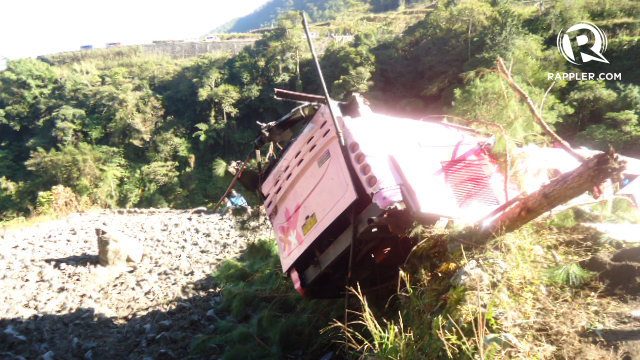SUMMARY
This is AI generated summarization, which may have errors. For context, always refer to the full article.

Editor’s Note: This is the conclusion of a 2-part series on corruption at the transportation regulatory agencies, Land Transportation Office and the Land Transportation Franchising and Regulatory Board.
READ: Part 1: Corruption at LTO, LTFRB: Unfit drivers, vehicles on the road
MANILA, Philippines – Charley Santa Maria, 33, rode a bus with her friends and their kids to Kalinga province in February 2014. They were supposed to celebrate one of the kids’ birthday.
There was no way to know of the tragedy that lay ahead. The bus driver lost control. In a few minutes, the bus lay at the bottom of a 400-meter deep ravine. Fourteen people died, including her friends.
This is not an isolated case. The Philippine National Police-Highway Patrol Group reported 15,572 vehicular accidents nationwide from January to December 2014 – 1,252 people died while 9,347 were injured.
The Land Transportation Franchising and Regulatory Board (LTFRB) and the Land Transportation Office (LTO) are the two government agencies tasked to ensure safe public travel. They work hand in hand – LTO in registering motor vehicles and licensing drivers, and the LTFRB in enforcing compliance of policies and franchises of PUVs.
The two, unfortunately, also work together in fraud and bribery that continuously result in passenger deaths and injuries. Corruption is so rampant and pervasive that any vehicle, in whatever condition, can be given the right to ply roads – rolling coffins for unsuspecting passengers like Sta Maria.
Modus operandi at the LTO
After an operator secures an LTFRB franchise through whatever means he sees fit, he needs to go to the LTO for vehicle registration and licensing of drivers.
The requirements for registration include: the franchise from LTFRB, circular, original Certificate of Registration and Official Receipt, 3rd-party liability insurance, and inspection of vehicle.
LTO employees receive bribes during the inspection of vehicles stage. The inspectors receive money from registrants in exchange for approval. Rica Lim,* a liaison officer for a company who deals with trucking services, said they pay P500 per truck for non-appearance “inspection”; the price for doing the process legally is only P150, plus waiting time.
“That’s a low amount. Others would pay P800 per unit. We do that because we do not want to bring all 260 or 300 trucks to LTO for inspection. Plus we will end up shelling more money if the inspectors see a problem with our units. They will bleed us dry because they know we need their approval,” Lim said.
LTO inspectors also receive at least P150 per unit for stencils of chassis and engine numbers if the details in the original Certificate of Registration is different from the actual numbers on the vehicle’s chassis and engine.
“They do not check the roadworthiness of the vehicles. There was a time we had two units whose chassis and engine do not match the original document because the operator changed them. The inspector just manually outlines the codes on the document,” Lim said.
There is also no effective way of checking vehicles that are already on the road.
Statistics from the Metropolitan Manila Development Authority (MMDA) show that 46% of the 10,000 buses that ply EDSA are “colorum” buses – they do not have the proper authorization to operate on the major thoroughfare. This is true in other regions of the country as well.
The GV Florida bus that Santa Maria was on in 2014 did not have the necessary papers to operate. The investigation showed that the plate number used, TXT-872, was issued to a bus from the Mountain Province Cable Tours owned by a certain Norberto Cue Sr.
There was also no application for “Approval for Sale and Transfer” to cover the license plate change, so the GV Florida bus had no business being on the road. (READ: LTFRB: Florida bus was ‘private’ vehicle)
License for sale
Drivers of PUVs are responsible for the lives of thousands of commuters, many of them having no other choice but to take public transportation. The LTO is tasked to ensure that these drivers obtain professional drivers’ licenses and that they strictly follow traffic rules.
However, just like in the LTFRB, fixers abound at LTO, both from the inside and out. MMDA records show that 867 drivers were caught driving with fake licenses from January to June 2013.
Ana Reyes* works as a fixer at LTO. She says any person can obtain a legal professional driver’s license for a minimum fee of P3,500, depending on negotiations. All the applicant has to do is sign the documents. There is no need for driving tests and written exams. (READ: The fixing business at LTO)
Most, if not all, fixers’ “home bases” are the lines of photocopy shops along East Avenue in Quezon City and those at the back of the LTO compound. Reyes said once a price is agreed upon, she or one of her fellow fixers accompanies the client inside the agency. Since the fixer knows whom to approach, a usual 3- to 5-hour ordeal is cut short to an hour.
There is another scheme that allows applicants to obtain valid licenses without appearing before the LTO. This is more expensive, ranging from P10,000 to P16,000, depending on negotiations. This usually happens in LTO offices in the provinces, but Reyes said it still occurs in Metro Manila.
Another kind of non-appearance is cheaper. It usually costs P1,500 to P2,500, but the license itself is fake as it is not registered in the LTO database.
“We know a lot of people inside the license and property divisions. We pay them, say, P1,000, and in exchange they would give us materials so we can print licenses on our own. We have the same computers that the LTO uses,” Reyes said.
Reyes said, however, that fixers hardly earn a lot from what they do. It is mostly LTO employees who earn thousands of pesos daily.
‘Do-it-yourself’ car registration
Joana Cruz* and Angela Ruiz* have been working in the LTO for at least 15 years. They said car dealers now have access to government records through the newly implemented scheme called “DIY” or “Do It Yourself” car registration.
LTO now allows car dealers to directly encode car information on government computers. Cruz said dealers have an office and individual computers inside the LTO main office in East Avenue.
According to her, management told them there are safety nets, as unaccredited users of the computers cannot access the system. The management also claims the operations division checks the information submitted by car dealers.
“LTO no longer encodes the information. How can they be sure that it is safe? The safety of government records is being compromised. How sure are they that the system cannot be faked or hacked?” Cruz said in Filipino.
“Now that the car dealers can encode on their own, what can stop them from tampering with the information? Let’s say a reconditioned bus from China arrives here. The dealers can make it appear brand new in the records,” Ruiz said.
No database for new plates
Although LTO chief Alfonso Tan and other officials say the new plates have added security features, Cruz said vehicles with new plates can be easily used for crimes, such as carnapping, kidnapping, and robbery.
Cruz said the LTO has no computer database for all cars with new plates. Cruz and Ruiz also said the agency has reverted to the old era as the LTO now manually encodes records on the computer.
Cruz said the LTO cannot include information on new plates in its database because the system of Stradcom, the IT provider, is compatible only with the old type of plates or those with 3 letters and 3 numbers.
Tan admitted this to Rappler. He, however, said the LTO created a new database in 2014 for the new 3-letter-4-number plates. Although such exists, the new database does not accommodate the old plates.
This means there is no centralized database in place – the legacy data from the old Stradcom system is not in the new LTO database and the new data is not in the old system.
“We are working on our new database so it can accommodate the data from the old system,” Tan said in an interview with Rappler.
The LTO database is crucial because it contains all information about registered vehicles in the country – type of vehicle, its registered owner, date of last registration, and whether or not it is included in the so-called pending alarm list. The pending alarm list shows if a vehicle was used in any unlawful act or was reported stolen by its owner.
This poses a great threat to passengers and motorists since all new plates are not available online and cannot be easily accessed. Moreover, in case of crimes or accidents, authorities and ordinary citizens cannot immediately determine or validate the registered owner of a particular vehicle since there is no centralized database.

Rappler verified this by texting 2600 or the LTO text hotline. It used to work until February. I texted both old and new plate numbers to check if they have details on those plate numbers. The service, however, is no longer available.
In an attempt to address the problem, Tan said Stradcom plans to conduct a two-week beta testing to see if the old Stradcom system will be able to accommodate information on new plates.
“No database at all. All cars with new plates are only recorded on paper. If you want to verify, it will be very difficult. Since plate release is centralized, you have to go to the regional office and of course there are more information to sift there,” Cruz explained in Filipino.
Second life
The accounts mentioned are just the tip of the iceberg. So many more schemes continue to prosper at the two land transport agencies.
In time, the memories of those who died in Benguet on that sunny February morning will fade, survived only by those they left and loved. (READ: Bus crash survivors: Don’t let GV Florida get off scott-free)
For Santa Maria, the bus crash was the start of her second life. The survivors say February 7, the day of the crash – the day they did not die – is their new birthday. – Rappler.com
If you have tips and inside information to share, email us at investigative@rappler.com.
*The real names of interviewees have been withheld for their own protection. This story was the author’s final project submitted last March 2015 for her post-graduate Investigative Journalism class at the Ateneo De Manila University.
Add a comment
How does this make you feel?
There are no comments yet. Add your comment to start the conversation.